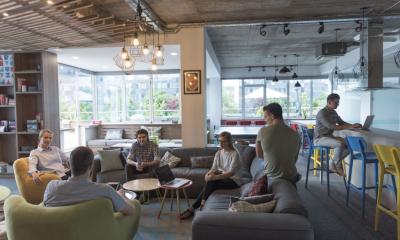
The pandemic dramatically changed the way in which we view work and, crucially, where work should take place.
Across predominantly knowledge-sector industries, millions of workers and their laptops now work from home either all or some of the time. Consequently, the nature of the workplace has changed from the place where all work takes place, to the space where we meet, share ideas, collaborate, and socialise.
In fact, eight in 10 of us post-pandemic say that the hybrid model of working is our ideal set-up according to a recent Future of Work report by Accenture.
This statistic is really important. It tells us that, yes, people enjoy the increased freedom to work from where they wish. But critically, they still want to work in a shared workspace - at least some of the time.
But are we still designing workplaces for computers, rather than the humans that use them? Are rows of desks and second screens actually what our people and productivity targets need?
Let's take a look.
What do we use the modern workplace for?
Previously defined by its permanence and uniformity, the modern office is now a fluid space, adapting to the needs of its users. Hybrid and remote working arrangements mean that many employees no longer have a permanent desk; instead, workspaces serve as docking stations where employees can connect their laptops, engage in light tasks, and collaborate as needed.
Modern workspaces are becoming increasingly multifunctional. Designed with flexibility in mind, they feature zones dedicated to various types of work - from individual tasks to group projects and casual interactions. These spaces are equipped to handle quick sync-ups or deep, focused work, depending on the immediate needs of the workforce. Integration of technology has been key, with high-speed internet and universal docking stations enabling employees to work efficiently from various locations within the office.
The importance of socialising is also key to the modern workplace - even if some organisations aren't too keen on promoting it. Offices are becoming hubs for interaction, places where employees share professional ideas and build relationships. The inclusion of communal areas, coffee bars, and even recreational zones like game rooms underscores the shift towards a workplace that values connection, collaboration, and wellbeing.
Why does it matter if workplaces look the same?
The prevalence of open-plan designs, while initially celebrated for fostering a sense of openness and teamwork, has revealed significant drawbacks. The lack of privacy, constant auditory distractions, and a one-size-fits-all approach to workspace layout have frequently been cited by employees as detrimental to productivity.
Many employees find the open-plan environment overwhelming and counterproductive, especially when trying to focus on complex tasks. This dissatisfaction highlights the need for office design that accommodates various working styles and preferences. Instead of a uniform landscape of desks and PCs, modern offices should offer a mixture of environments. Quiet zones for deep concentration, collaborative spaces for team-based work, and private pods for confidential discussions, calls and video meets can coexist.
In such a diverse setting, the design of the workplace directly impacts employee morale and effectiveness. By moving away from a rigid, PC-centric layout, businesses can create spaces that are truly conducive to modern ways of working.
What modern workspaces will become
Looking forward, the office of the future will be an even more dynamic entity, built with the dual goals of functionality and comfort. Adaptive lighting systems that adjust based on the time of day and ergonomic furniture designed to support posture and reduce strain will become standard, enhancing the physical comfort of employees.
The focus on inclusivity in office design will only increase. Workspaces will be tailored to meet the needs of all employees, including those with disabilities, ensuring accessibility and comfort for everyone. Features such as variable height desks, tactile indicators for the visually impaired, and soundproofed areas for those with auditory sensitivities will become more prevalent.
Collaboration with specialist office interior design firms will be crucial in achieving these goals. These experts can provide insights and innovations that transform traditional office spaces into vibrant, effective workplaces that attract top talent and foster a productive, satisfied workforce.
As we continue to redefine what it means to go to 'work', the shift from PC-centric to human-centric office designs is not just a trend but a necessary evolution. In creating spaces that prioritise the needs of the people who use them, we can ensure that our workplaces remain a relevant and productive part of the working week.
Copyright 2024. Featured post made possible by Truline.
